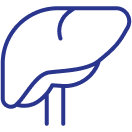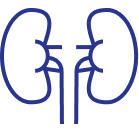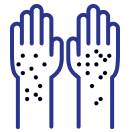Sly Saint
Senior Member (Voting Rights)
Overview
Castleman disease is a group of rare disorders characterized by lymph node enlargement, specific microscopic changes to the lymph nodes, and a range of symptoms and laboratory findings.
Castleman disease has a broad spectrum of disease severity, ranging from mild compressive symptoms and fatigue to life-threatening multi-organ failure. Symptoms of Castleman disease often overlap with symptoms of other more common illnesses which makes diagnosis difficult. A Castleman disease diagnosis can only be made with a lymph node biopsy that shows characteristic Castleman disease features and when all other illnesses have been evaluated and excluded.
Symptoms of unicentric Castleman disease (UCD)
In unicentric Castleman disease (UCD), enlarged lymph nodes appear in only one region of the body.
- UCD symptoms tend to be mild and occur secondary to compression of surrounding structures by rapidly enlarging lymph nodes.
- Less commonly, some UCD patients can experience systemic inflammatory symptoms such as fatigue and laboratory abnormalities such as low hemoglobin and elevated C-reactive protein.
Symptoms of multicentric Castleman disease (MCD)
In multicentric Castleman disease (MCD), enlarged lymph nodes appear in multiple regions of the body. Symptoms occur due to a systemic hyperinflammatory response an tend to be more severe than UCD symptoms

Flu-like symptoms (fever, night sweats, loss of appetite, nausea, and vomiting)

Edema (swelling), ascites (fluid accumulation in the abdomen), and/or other symptoms of fluid accumulation

Unintentional weight loss

Weakness, fatigue

Enlarged liver or spleen

Kidney dysfunction

Peripheral neuropathy (numbness in the hands and feet)

Cherry hemangioma skin rash
Signs & Symptoms - Castleman Disease Collaborative Network | CDCN
Castleman disease is difficult to diagnose because of its wide range of symptoms that are often initially misdiagnosed as other ailments.

Castleman disease - Wikipedia
Understanding the complex spectrum of Castleman disease: Castleman disease (CD) is a rare, non-clonal lymphoproliferative disorder that manifests with a wide range of histologic and clinical features. It is classified clinically into unicentric (UCD) and multicentric (MCD) forms and histopathologically into hyaline vascular (HV-CD), plasma cell (PC-CD), and mixed types. UCD typically presents as an isolated lymph node enlargement, often asymptomatic, whereas MCD involves multiple nodal sites and systemic symptoms. MCD may be associated with human herpesvirus 8 (HHV8), idiopathic origins (iMCD), POEMS syndrome, or TAFRO syndrome. Given its overlap with various reactive and neoplastic diseases, CD is diagnostically challenging and often mimicked by other conditions.

Understanding the complex spectrum of Castleman disease
Castleman disease (CD) is a rare, non-clonal lymphoproliferative disorder that manifests with a wide range of histologic and clinical features.
(I'd not heard of this. I found it interesting from a number of perspectives, not least the name, given that
"In 2018, the first treatment guidelines for iMCD were established. In 2020 the first evidence based diagnostic criteria and treatment guidelines were established for unicentric Castleman disease." and there are 4 classifications.)
